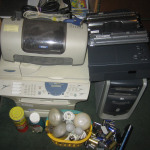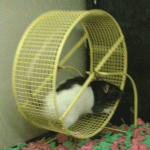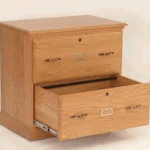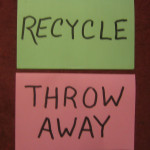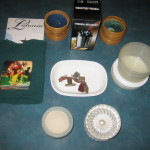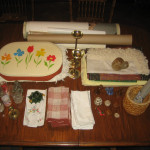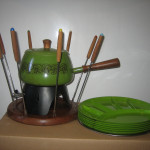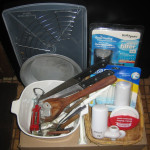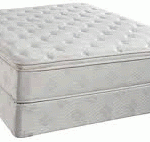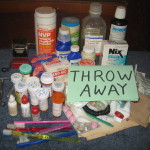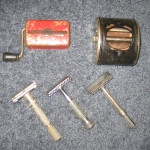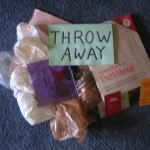NOTE: This week’s blog is longer than usual. Skip to the end, LESSONS LEARNED, if you just want the bottom line – though this means you may miss my humor too. 🙂
Lent is a penitential season so I have a confession to make. I haven’t been cleaning out A-Drawer-A-Day. In the interest of saving time, I’ve usually waited till the weekend and then did 7 days at once. It simplified my life. But, in the interest of authenticity I decided I should at least try A-Drawer-A-Day to see if it really was that much more inconvenient or if it really felt easier.
DAY 1: Since I hadn’t finished all the cabinets in the kitchen last week, I chose a pretty big cabinet. It may have actually equaled 3 or so drawers but I thought, “Heck, I’m only doing one today, I can handle this.” Besides, I suspected I wouldn’t have much to give away, and it would at least get cleaned. I was right that there wasn’t much to give away and the cabinet did get cleaner (I remembered to use rags today instead of paper towels like last week.) The only thing I found to remove were plastic food storage containers. But here was the problem. Some of the lids didn’t fit. Some of the bottoms didn’t have lids. And some of the lids didn’t have bottoms.
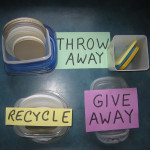 Keep: 32 containers
Keep: 32 containers
Give Away: 1 container with matching lid that was an odd size
Recycle: 11 mismatched lids and bottoms that had a triangle on them
Throw Away: 24 mismatched or duplicate lids and bottoms that didn’t have a triangle
Time: 2 hours. Fortunately/unfortunately in the process of sorting and reorganizing I noticed that the shelf was uneven and decided to put a new brace under it. These projects always seem to escalate.
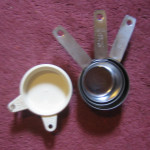 DAY 2: After my satisfying but time consuming experience on Day 1, I decided that I would need to redefine how many cabinet sections equaled one drawer. I decided to count each cabinet door as one drawer. (According to this definition I have 16 remaining “drawers” in the kitchen although many of them probably won’t have anything to remove.
DAY 2: After my satisfying but time consuming experience on Day 1, I decided that I would need to redefine how many cabinet sections equaled one drawer. I decided to count each cabinet door as one drawer. (According to this definition I have 16 remaining “drawers” in the kitchen although many of them probably won’t have anything to remove.
Give Away: 5 measuring cups that had been hidden behind food boxes.
Time: 10 minutes. (Now that’s a lot more reasonable.)
DAY 3: (staples like oils, vinegars, measuring cups…)
Give Away: 0, but I have 3 much cleaner shelves 🙂
Time: 15 minutes. According to my original rule of finding at least one thing a day, I should have gone on to the next door but I thought that 15 minutes was a reasonable amount of time to spend each day, so I decided to stop. (She who maketh the rule can changeth the rule.) If I make this too time consuming, it will sabotage my motivation.
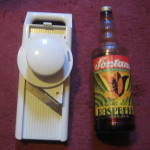 DAY 4: (odds & ends)
DAY 4: (odds & ends)
Give Away: 1 Kitchen Slicer (with 4 blades)
Recycle: 1 very old bottle of raspberry syrup (I love all things raspberry but this bottle was almost empty and even I had to admit that the syrup looked a lot thicker than when I remember last using it about 5 years ago.
Time: 10 minutes
+ 5 minutes trying to see if I could readjust the cabinet door to close more tightly
+ 5 minutes trying to soften the raspberry syrup so I could empty the bottle to recycle it
+ 5 minutes consulting with Jim about whether we would ever use the Kitchen Slicer enough to warrant keeping it.
DAY 5:
Door #1: Blender
Give Away: 0 – I’m keeping the blender.
Time: 4 minutes to clean. Since I didn’t remove anything and it was quick, I moved on.
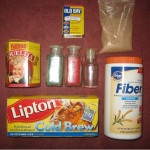 Door #2: (3 shelves containing spices, teas, coffees etc.)
Door #2: (3 shelves containing spices, teas, coffees etc.)
Give Away: 0 – Still nothing worth giving away but definitely some things to recycle or throw away
Combined: chili powder, pickling spices, Old Bay seafood seasoning
Recycled or Threw Away:
– Large Fiber bottle (exp. date 2011)
– Mexican chocolate bar for cooking (out of 2)
– 5 Lipton tea bags. We prefer herbal teas.
– Very old green and red sprinkles (I don’t do Xmas cookies.)
– Unidentified powder in a plastic bag.
Wait:
– MSG
– Alum powder
Time: 40 minutes (about 13 minutes a shelf) Perhaps I should have considered a shelf to be a drawer, but a rule is a rule and I’m sticking to it, even if I did make it myself. There’s nothing like consistency. 🙂
+ 5 minutes to check the use of MSG and Alum and how harmful either might be
+ 5 minutes to consult with Jim about what he wanted to keep
+ 5 minutes preparing the stuff that was to be recycled
Hmmm. All told, this took longer than I expected.
 DAY 6: (Alcohol)
DAY 6: (Alcohol)
Door #1: 0 (Kept some alcohol basics, an ice crusher, and a flask)
Time: 3 minutes
Door #2:
Throw Aways:
– 1 bottle of vermouth we bought about 20 years ago to make martinis when my parents visited. Since it was opened and old, I suppose I’ll just throw it away.
– 1 tiny bottle of Mirabelle de Lorraine
Time: 4 minutes
+2 minutes on the internet to find out what Mirabelle de Lorraine is (a plum brandy from France)
+12 minutes to clean the dust off the top of the refrigerator which sits below these two liquor cabinets
DAY 7
Door #1: 0 – Kept all the cereals that we regularly eat
Time: 1 minute
Door #2: 0 – Kept our daily medicines and a microwave lid
Time: 2 minutes
 Door #3: glasses and mismatched mugs
Door #3: glasses and mismatched mugs
Give Away: 1 mug This might seem to be a rather paltry give away but the advantage of mismatched mugs is that we can give them to company and each person has their unique mug. However, 2 mugs matched so I’m giving away one so no one will get confused and share germs.
Time: 10 minutes
PAUSE – OK, so I accomplished one give away today and should stop, BUT, there’s only one door left in this area and I know it is pretty clean and contains stuff we use every day so it should be easy.
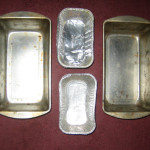
Click to enlarge & see how decrepit these are.
Door #4: (pots, pans, and mixing bowls)
Give Away/Throw Away?
– 2 old, somewhat corroded, bread pans. We still have 6 good ones.
– 10 mini bread pans. Some would call these disposable, but I know we used them more than once.
Time: 5 minutes
LESSONS LEARNED:
1. Don’t give advice without testing it.
A-Drawer-A-Day sounded like an easy starting point for beginning simplifiers. I still think that holds, but it can be complicated by what you consider a drawer. When my kitchen drawers were finished I started on my cabinets. In hindsight, if my aim was to do this in small bites, I would have counted each kitchen door shelf as a drawer. Calculating this way (and not counting side repair projects) I averaged 7 minutes per “drawer.” That would be pretty doable for most people.
2. It’s hard to stop.
Once I got into cleaning a drawer, I found other peripheral projects like cleaning the tops of the cabinet doors or repairing shelves. This can be a pro or a con. The momentum of starting a cabinet motivated me to fix related things in my way. If time is limited, however, it can discourage continuing the next day lest it escalate into a bigger than anticipated project.
3. Don’t be a slave.
I started out with a plan to find at least one thing a day to give away (or at least throw away). As circumstances changed, I needed to not be a slave – even to my own rules. Do what works for you.
4. It’s worth it?
Even when I didn’t give anything away, it was worth it to:
– Find lost things
– Get the drawers cleaner
– Combine and get rid of duplicates”
– Be able to find things more quickly in uncluttered drawers
Question: I’m wondering what kitchen supplies other people would choose to keep or pitch?
